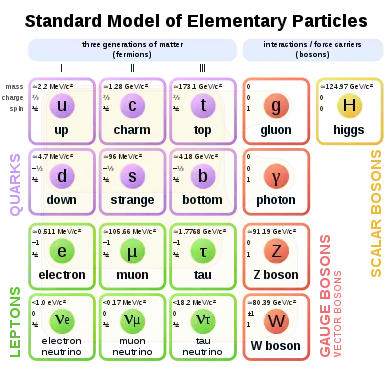Chargino
In particle physics, the chargino is a hypothetical particle which refers to the mass eigenstates of a charged superpartner, i.e. any new electrically charged fermion (with spin 1/2) predicted by supersymmetry.[1][2] They are linear combinations of the charged wino and charged higgsinos. There are two charginos that are fermions and are electrically charged, which are typically labeled
C±
1 (the lightest) and
C±
2 (the heaviest), although sometimes and are also used to refer to charginos, when is used to refer to neutralinos. The heavier chargino can decay through the neutral Z boson to the lighter chargino. Both can decay through a charged W boson to a neutralino:
C±
2 →
C±
1 +
Z0
C±
2 →
N͂0
2 +
W±
C±
1 →
N͂0
1 +
W±
| Standard Model of particle physics |
|---|
 |
References
- Klapdor-Kleingrothaus, H. V.; Krivosheina, I. V. (1999). Lepton and Baryon Number Violation in Particle Physics, Astrophysics and Cosmology: Proceedings of the First International Symposium on Lepton and Baryon Number Violation (Lepton-Baryon 98), European Centre for Theoretical Studies (ECT), Trento, Italy, 2. CRC Press. p. 469. ISBN 978-1-4822-6863-8. Retrieved 19 June 2020.
- Abazov, V. M.; et al. (2005). "Search for Supersymmetry via Associated Production of Charginos and Neutralinos in Final States with Three Leptons". Physical Review Letters. 95 (15): 151805. arXiv:hep-ex/0504032. Bibcode:2005PhRvL..95o1805A. doi:10.1103/PhysRevLett.95.151805. PMID 16241718. Lay summary.
External links
- http://lepsusy.web.cern.ch/lepsusy/www/inoslowdmsummer02/charginolowdm_pub.html
- Alloul, Adam; Frank, Mariana; Fuks, Benjamin; De Traubenberg, Michel Rausch (2013). "Chargino and neutralino production at the Large Hadron Collider in left-right supersymmetric models". Journal of High Energy Physics. 2013 (10): 033. arXiv:1307.5073. Bibcode:2013JHEP...10..033A. doi:10.1007/JHEP10(2013)033.
This article is issued from Wikipedia. The text is licensed under Creative Commons - Attribution - Sharealike. Additional terms may apply for the media files.
